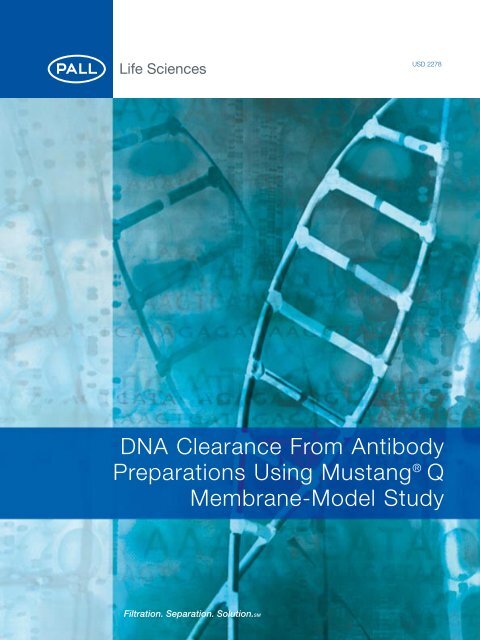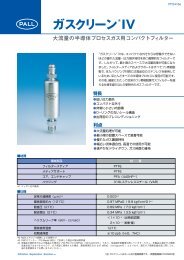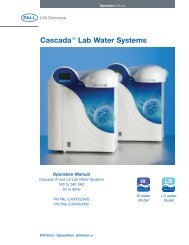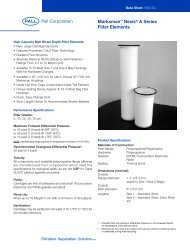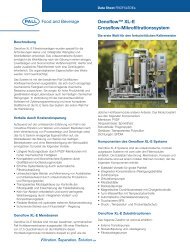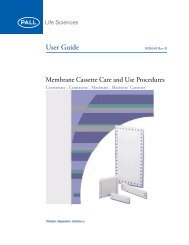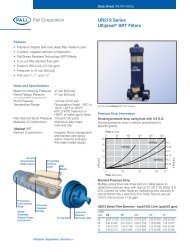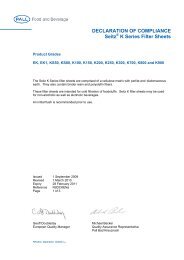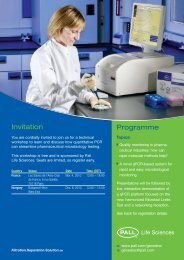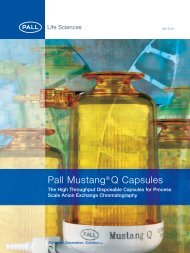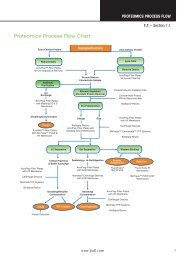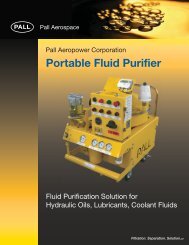DNA Clearance From Antibody Preparations Using Mustang® Q ...
DNA Clearance From Antibody Preparations Using Mustang® Q ...
DNA Clearance From Antibody Preparations Using Mustang® Q ...
Create successful ePaper yourself
Turn your PDF publications into a flip-book with our unique Google optimized e-Paper software.
USD 2278<br />
<strong>DNA</strong> <strong>Clearance</strong> <strong>From</strong> <strong>Antibody</strong><br />
<strong>Preparations</strong> <strong>Using</strong> Mustang ® Q<br />
Membrane-Model Study<br />
2
<strong>DNA</strong> <strong>Clearance</strong> <strong>From</strong> <strong>Antibody</strong> <strong>Preparations</strong> <strong>Using</strong><br />
Mustang Q Membrane-Model Study<br />
Introduction<br />
Why Remove <strong>DNA</strong><br />
The world market demand for monoclonal<br />
IgG's and recombinant protein is growing<br />
rapidly. Improvements in cell culture techniques<br />
have significantly improved the efficiency of<br />
monoclonal production with concentrations of<br />
monoclonal antibody of over 1g per liter, being<br />
reported in hybridoma supernatants.<br />
However, during the cell growth and the<br />
harvesting steps of the cells, a certain amount<br />
of nucleic acid may contaminate the product<br />
of interest. The nucleic acid contamination<br />
may come from the host cell <strong>DNA</strong>-either<br />
genomic, vector-or retroviral RNA, which is<br />
considered a greater risk. Fragments of sizes<br />
larger than 2 kilobases are considered to be<br />
potentially carcinogenic, and therefore nucleic<br />
acids have to be removed from the final product.<br />
The Center for Biological Evaluation and<br />
Research (1) in the USA, initially defined the<br />
maximum allowable nucleic acid contamination<br />
as 10 pg per dose. The World Health<br />
Organisation (2) has stated that 100 pg per dose<br />
could be acceptable. More recently, a newer<br />
'Point to consider' from the CBER (3) now states<br />
that "Lot to lot testing for <strong>DNA</strong> contents in<br />
biological products produced in cell lines<br />
should be performed and lot release<br />
limits established that reflect a level of purity<br />
that can be achieved reasonably and<br />
consistently." This all suggests that a rapid<br />
and cost efficient method which clears nucleic<br />
acid to below acceptable (and ideally<br />
detectable) levels is required.<br />
Why use Membrane Chromatography to Remove <strong>DNA</strong><br />
Several methods are available for nucleic with a larger surface area and therefore fewer<br />
acid removal. Among them, we can mention diffusion limitations. At the same time<br />
anion exchange chromatography, which has Mustang Q membrane when compared<br />
proved to be quite effective due to the high to conventional resin based media has<br />
negative charge of nucleic acids, which bind at least a 10 fold higher binding capacity<br />
at high ionic strengths and at pH >2. Under (25 mg <strong>DNA</strong> / mL of media) combined<br />
these conditions most biotherapeutic proteins with much higher flow rates (more than<br />
do not interact with anion exchange matrices. 10 CV / min).<br />
Therefore, anion exchange (4, 5) as a first step<br />
These units have thus been designed as<br />
is generally considered to be suitable as it can<br />
capsules and cartridges for single use<br />
contribute to reduce the viscosity of the<br />
disposable product. Therefore, neither<br />
protein feed stream. Alternatively, both cation<br />
cleaning nor cleaning validation is necessary,<br />
exchange in a flow through mode and<br />
which is helpful because it can be difficult<br />
nucleases (6, 7) have been used for removal of<br />
or impossible to demonstrate complete<br />
contaminating nucleic acids.<br />
removal of nucleic acids when cleaning<br />
Although conventional anion exchange resin conventional resin media.<br />
chromatography can be used to remove<br />
nucleic acid impurities, <strong>DNA</strong> is a very large<br />
biomolecule (can be up to 500 nm in diameter<br />
compared to a typical 1-10 nm globular<br />
protein) and it has difficulties diffusing into the<br />
small pores (20-100 nm) of resin beads. In<br />
contrast, Mustang Q anion exchange<br />
membrane has much larger pores (800 nm)<br />
2
<strong>DNA</strong> <strong>Clearance</strong> <strong>From</strong> <strong>Antibody</strong> <strong>Preparations</strong> <strong>Using</strong><br />
Mustang Q Membrane-Model Study<br />
Large <strong>DNA</strong> molecules<br />
have direct convective<br />
access to Mustang Q<br />
membrane groups<br />
without steric hindrance<br />
Beads 1µm Mustang<br />
slow<br />
fast<br />
slow<br />
slow<br />
fast<br />
slow<br />
fast<br />
fast<br />
slow<br />
fast<br />
fast<br />
fast<br />
fast<br />
fast<br />
fast<br />
fast fast<br />
Figure 1: Comparison of molecular<br />
access of nucleic acids in membranes<br />
and conventional gel media<br />
Solid surface<br />
Area of diffusive flow<br />
Area of convective flow<br />
• 150 Å diameter globular protein<br />
<strong>DNA</strong> (20,000 bp fragments shown)<br />
What is Mustang Q Media <br />
Mustang Q membrane is made by coating<br />
and tightly crosslinking a highly stable<br />
hydrophilic quarternary amine polymer onto<br />
the surface of polyethersulfone membrane.<br />
The end result is a membrane with an open<br />
nodular structure which has the benefits of a<br />
high surface area and binding capacity for<br />
negatively charged macromolecules, combined<br />
with good mechanical properties, including<br />
800 nm pores to allow for very high flow rates.<br />
Single use Mustang Q units are made of 16<br />
layers of this membrane which are then pleated<br />
and assembled into a ready-to-use capsule<br />
format. The Mustang coin unit is a scaled<br />
down version of the Mustang capsules. It is<br />
ideal for performing scale down experiments,<br />
particularly for validation studies.<br />
The coin unit uses the same 16 layer<br />
Mustang Q membrane that is used in<br />
Mustang Q capsules and cartridges.<br />
<strong>Clearance</strong> of Calf Thymus <strong>DNA</strong> from a<br />
Polyclonal IgG Preparation <strong>Using</strong> the<br />
Mustang Q Media<br />
The goal of the experiments was to find loading<br />
conditions (buffer composition, pH and ionic<br />
strength) under which <strong>DNA</strong> but not an Ig G<br />
preparation, binds to Mustang Q membrane.<br />
Every monoclonal antibody has a different pI<br />
which will determine its ability to bind to<br />
Mustang Q membrane at any given pH.<br />
Therefore it is difficult to establish a method<br />
suitable for every monoclonal antibody with<br />
Mustang Q membrane, based on just one<br />
example. For this reason we chose a bovine<br />
Ig G preparation which contains many different<br />
Ig G's with a broad spectrum of pI's , therefore<br />
covering many possible eventualities.<br />
Due to its relatively large size and highly<br />
polyanionic nature above pH 2, <strong>DNA</strong> has a<br />
very high affinity for anion exchange<br />
membranes compared to smaller and more<br />
neutrally charged antibodies. Therefore it was<br />
predicted that binding in slightly acidic and<br />
<strong>Clearance</strong> of Calf Thymus <strong>DNA</strong> from a<br />
Polyclonal IgG Preparation <strong>Using</strong> the<br />
Mustang Q Media<br />
moderate ionic strength-should favor <strong>DNA</strong><br />
binding and result in the Ig G fraction having<br />
very little or no interaction with the anionexchange<br />
Mustang Q membrane. To make<br />
separation more challenging and applicable<br />
to industrial applications, the experiments were<br />
carried out using phosphate buffers (as a worst<br />
case scenario) which normally interfere with<br />
anion exchange chromatography due to the<br />
high ionic strength and multiple negative charge<br />
of the phosphate anion.<br />
3
<strong>DNA</strong> <strong>Clearance</strong> <strong>From</strong> <strong>Antibody</strong> <strong>Preparations</strong> <strong>Using</strong><br />
Mustang Q Membrane-Model Study<br />
Protocols and Results<br />
Three separate experiments were carried out,<br />
using first <strong>DNA</strong> alone then polyclonal Ig G<br />
alone and finally a combination of both.<br />
For the first experiment (Figure 2a), a solution<br />
of Calf Thymus <strong>DNA</strong> was made up to a<br />
concentration of 20 µg/mL in 25mM Sodium<br />
Phosphate buffer pH 6.0 + 150 mM NaCl.<br />
A total of 360 mL (7 mg) of this solution was<br />
In the final experiment (Figure 2c), 380 mL of<br />
a bovine Immunoglobulin G solution (4 mg/mL<br />
in phosphate buffer) was spiked with<br />
Calf Thymus <strong>DNA</strong> (20 µg/mL) and subsequently<br />
loaded on Mustang Q coin using the<br />
conditions described in Experiment 1.<br />
Absorbance at 260 and 280 nm were<br />
continuously monitored. <strong>DNA</strong> breakthrough<br />
was obtained at 322 mL as judged by an<br />
increase in absorbance at 260 nm. Washing<br />
and elution were carried out according<br />
to Experiment 1 and 14 mL fractions<br />
collected and assayed for <strong>DNA</strong> content<br />
using our own <strong>DNA</strong> hybridization testing<br />
method described in the application note<br />
USD 2279 (Figure 3).<br />
loaded on to a Mustang Q coin equilibrated<br />
with 25 mM Sodium Phosphate buffer pH 6.0<br />
+ 150 mM NaCl at 20 CV/min, while monitoring<br />
absorbance at 260 nm. After washing with 40<br />
membranes volumes of equilibration buffer,<br />
bound <strong>DNA</strong> was eluted by a gradient of<br />
150 to 1000 mM NaCl in 40 CV of equilibration<br />
buffer. Breakthrough was obtained at<br />
approximately 315 mL, as indicated by an<br />
increase in absorbance at 260 nm.<br />
Absorbance (260nm)<br />
1.8<br />
1.6<br />
1.4<br />
1.2<br />
1.0<br />
0.8<br />
0.6<br />
0.4<br />
0.2<br />
0<br />
1 3 5 7 9 11 13 15 17 19 21 23 25 27 29 31 33<br />
Fraction Number<br />
Figure 2a: Calf Thymus <strong>DNA</strong><br />
100<br />
90<br />
80<br />
70<br />
60<br />
50<br />
40<br />
30<br />
20<br />
10<br />
0<br />
Conductivity (mS/cm)<br />
This first experiment determined that Calf<br />
Thymus <strong>DNA</strong> elutes in these conditions above<br />
at a salt concentration greater than 500 mM.<br />
For the second experiment (Figure 2b), a<br />
solution of Bovine Immunoglobulin G was<br />
made up to a concentration of 2 mg/mL in<br />
equilibration buffer. A total of 380 mL (760 mg)<br />
Absorbance (280nm)<br />
1.8<br />
1.6<br />
1.4<br />
1.2<br />
1.0<br />
0.8<br />
0.6<br />
0.4<br />
0.2<br />
0<br />
1 3 5 7 9 11 13 15 17 19 21 23 25 27 29 31 33 35<br />
100<br />
90<br />
80<br />
70<br />
60<br />
50<br />
40<br />
30<br />
20<br />
10<br />
0<br />
Conductivity (mS/cm)<br />
of this Immunoglobulin G solution was loaded<br />
Fraction Number<br />
on to a Mustang Q coin using exactly the<br />
same method as described for Experiment 1,<br />
and absorbance at 280 nm was continuously<br />
monitored. Washing and elution were carried<br />
out according to Experiment 1.<br />
This second experiment demonstrated that in<br />
the chosen conditions, the chosen bovine<br />
Immunoglobulin G does not bind to Mustang<br />
Q Media.<br />
Experiments 1 and 2 determined the optimum<br />
conditions under which no globulin binds (the<br />
product of interest) while <strong>DNA</strong> binds (the<br />
impurity) to Mustang Q media.<br />
Figure 2c: Bovine Gamma Globulin<br />
Absorbance<br />
1.8<br />
1.6<br />
1.4<br />
1.2<br />
1.0<br />
0.8<br />
0.6<br />
0.4<br />
0.2<br />
AU (260nm)<br />
AU (280nm)<br />
0<br />
1 3 5 7 9 11 13 15 17 19 21 23 25 27 29 31 33 35 37<br />
Fraction Number<br />
Figure 2c: Calf Thymus <strong>DNA</strong> and Bovine Gamma Globulin<br />
Figure 2. Chromatogram of respectively Calf thymus <strong>DNA</strong> (a) Bovine Ig G solution (b) and Bovine<br />
Ig G solution spiked with Calf Thymus <strong>DNA</strong>(c) on Mustang Q coin<br />
Adsorption and washing buffer: Phosphate 25 mM pH 6.0 + 150 mM NaCl<br />
Elution buffer: gradient of 150 to 1000 mM NaCl in 40 CV of equilibration buffer<br />
100<br />
90<br />
80<br />
70<br />
60<br />
50<br />
40<br />
30<br />
20<br />
10<br />
0<br />
Conductivity (mS/cm)<br />
4
<strong>DNA</strong> <strong>Clearance</strong> <strong>From</strong> <strong>Antibody</strong> <strong>Preparations</strong> <strong>Using</strong><br />
Mustang Q Membrane-Model Study<br />
Under the conditions chosen in these<br />
experiments, Calf Thymus <strong>DNA</strong> binds strongly<br />
to Mustang Q membrane. The hybridization<br />
test demonstrated that no <strong>DNA</strong> was detected<br />
Fraction 5<br />
until fraction 24 (sensitivity of the assay is<br />
2.5 pg/mL). It supports the fact that there<br />
is no <strong>DNA</strong> breakthrough detected by P 32<br />
<strong>DNA</strong> hybridization (Figure 3) until saturation<br />
Fraction 24<br />
is obtained (with binding capacities of<br />
18.5 and 18.3 mg/mL of Mustang Q membrane<br />
for Experiments 1 and 3 respectively).<br />
Fraction 25<br />
At the same time, very little binding of<br />
Immunoglobulin G (< 0.5% of the total) binding<br />
is taking place (as adjudged by absorbance<br />
25<br />
at 280 nm) which demonstrates a very<br />
good recovery of the product of interest.<br />
20<br />
Discussion<br />
The experiments demonstrate very efficient<br />
<strong>DNA</strong> µg/mL<br />
15<br />
10<br />
Filtrate<br />
Starting Solution<br />
removal of Calf Thymus <strong>DNA</strong> by Mustang Q<br />
5<br />
membrane in the presence of a bovine Ig G.<br />
This supports the fact that Mustang Q<br />
0<br />
membranes can be used for the efficient<br />
0 1 5 9 13 17 21 25<br />
removal of nucleic acids from both polyclonal<br />
Fraction<br />
and most probably monoclonal antibodies<br />
preparations to below both detectable and<br />
Figure 3: Results of <strong>DNA</strong> Challenge Test<br />
acceptable levels according to current<br />
FDA guidelines.<br />
5
<strong>DNA</strong> <strong>Clearance</strong> <strong>From</strong> <strong>Antibody</strong> <strong>Preparations</strong> <strong>Using</strong><br />
Mustang Q Membrane-Model Study<br />
<strong>Clearance</strong> of Nucleic Acid from a<br />
Monoclonal Cell Culture Supernatant<br />
The aim of this experiment was to demonstrate<br />
that a similar approach to the one described<br />
above could be applied to the use of<br />
Mustang Q membrane for <strong>DNA</strong> removal from<br />
a very complex solution such as cell culture<br />
supernatant.<br />
Protocols and Results<br />
A Monoclonal Cell Line was grown to a density<br />
of 1 x 10 6 cells per mL in RPMI 1640 media<br />
and the supernatant collected after<br />
centrifugation of the cells. This supernatant<br />
was pre-filtered to 0.2 µm using Supor ® media<br />
and then the pH was readjusted to 6.0 after<br />
addition of 50 mM Sodium Phosphate buffer<br />
pH 6.0. Supernatant (10 mL) was loaded on<br />
to a Mustang Q coin previously equilibrated<br />
with Sodium Phosphate buffer pH 6.0<br />
containing 150 mM NaCl at 10CV / min. The<br />
flow through was collected and assayed for<br />
<strong>DNA</strong> along with the starting material using the<br />
<strong>DNA</strong> hybridization method developed by Pall.<br />
During the experiment, absorbance at 280 nm<br />
(protein concentration) and conductivity (salt<br />
concentration) were continuously monitored<br />
as described in Figure 4.<br />
Absorbance (280nm)<br />
1.00<br />
0.90<br />
0.80<br />
0.70<br />
0.60<br />
0.50<br />
0.40<br />
0.30<br />
0.20<br />
0.10<br />
0.00<br />
-0.10<br />
Flow Through<br />
00:00:00 00:05:00 00:10:00 00:15:00 .<br />
Hr:Min:Sec<br />
Fractions<br />
Figure 4: Chromatogram of cell culture supernatant (10 mL) loaded on Mustang Q Coin<br />
Adsorption and washing buffer: Phosphate 25 mM pH 6.0 + 150 mM NaCl<br />
Elution buffer: gradient of 150 to 1000 mM NaCl in 40 CV of equilibration buffer<br />
Flow rate: 10 CV/min<br />
100.0<br />
90.0<br />
80.0<br />
70.0<br />
60.0<br />
50.0<br />
40.0<br />
30.0<br />
20.0<br />
10.0<br />
0.00<br />
-10.0<br />
Conductivity (mS/cm)<br />
Discussion<br />
The experiment demonstrated that using the<br />
chosen conditions, Mustang Q membrane<br />
allows for the removal of <strong>DNA</strong> while the proteins<br />
of interest did not bind on the media. The<br />
hybridization test showed that while the initial<br />
level of contamination was 8 pg of <strong>DNA</strong>/ mL<br />
of cell culture supernatant, after passage<br />
through the Mustang Q coin this level was<br />
reduced to below detection level (2.5 pg/mL).<br />
These results demonstrate that Mustang Q<br />
membrane chromatography is a very suitable<br />
method for the removal of <strong>DNA</strong> from complex<br />
solutions, and can even be applied at early<br />
stages of the purification processes on crude<br />
protein solutions.<br />
Pre Mustang Media Flow ThroughFractions (Post Mustang media) Calibration Standards<br />
Figure 5: <strong>DNA</strong> Hybridization analysis cell culture supernatant loaded on Mustang Q Coin<br />
6
Conclusion<br />
We have demonstrated that anion exchange chromatography using<br />
membrane technology can be an excellent alternative to the use of<br />
conventional gel resins for nucleic acid removal as it allows removal of<br />
nucleic acids below the level requested by regulatory authorities.<br />
Membrane chromatography used in a disposable format significantly<br />
reduces the validation time as both column packing and cleaning validation<br />
will not be required. The pH and salt conditions at which the product of<br />
interest does not bind to the Mustang membrane, but the nucleic acids<br />
do bind, have to be determined in each case. Due to the very high<br />
negative charge of nucleic acid, this can be easily achieved with the vast<br />
majority of monoclonal antibodies and recombinant proteins produced<br />
by mammalian cell culture or any other sources.<br />
Nucleic acid removal was obtained at high flow rates, as typically flow<br />
rates from 10 to 20MV/min have been used, allowing clearance in minutes<br />
rather than in hours. In fact, Mustang Q membranes have a very high<br />
dynamic binding capacity (in the above conditions around<br />
18 mg of <strong>DNA</strong> were bound per mL of membrane) that is independent of<br />
flow rate due to their convective pores. Resins, on the other hand have<br />
dynamic binding capacities that are very flow rate dependent due to<br />
their numerous diffusive pores. The experiments performed at small<br />
scale suggests that for a typical antibody where the initial contamination<br />
level is around 5 µg/mL in the cell culture supernatant, a Kleenpak TM Nova<br />
10 inch (NP6) capsule could be used to clear 1000 L of cell culture<br />
supernatant in less then 2 hours. This high throughput technology is<br />
ideal for contaminant and impurities removal from biomolecules which<br />
are very susceptible to degradation.<br />
27
References<br />
(1) US FDA. Points to consider in the Production and Testing of New Drugs and Biologics Produced<br />
by Recombinant <strong>DNA</strong> Technology (1985)<br />
(2) Acceptability of all substrates from production of biologicals. Report of a WHO group.<br />
Technical report Series 757; World Health Organisation, Geneva (1987)<br />
(3) US FDA. Points to consider in the Characterization of Cell Lines used to Produce Biologicals.<br />
FDA, Rockville, MD (1993)<br />
(4) R.D. Sitrin, P. de Phillips, Challenges in developing commercial scale bioseparation and biopurification<br />
processes. International Biotechnology Expo Scientific Conference, Oct. 24, 1990. Oral Presentation<br />
(5) R.W. van Leen, J.G. Bachuis, R. van Beckhoven, H.Burger, L.C.J. Dorssers, R.W.J. Hommes,<br />
P.J. Lemsons; B. Noorclam, N.L/M. Persoon and G. Wagemaker, Production of human<br />
interleukin-3 using industrial microorganisms. Bio/Technology 9, 47-52 (1991)<br />
(6) STREAMLINE ® and Protein A Data file. Pharmacia Biotech Uppsala (1996)<br />
(7) A.L. van Wezel, P. van der Marel, C.P. van Beveren, I. Verma, P.L. Salk and J. Salk,<br />
Detection and elimination of cellular nucleic acids in biologicals produced on continuous cell lines.<br />
Dev. Biol.Standard. 50, 59-69 (1982)<br />
Technical Support<br />
Telephone: US Toll-Free (800) 859-3245<br />
International (1) 850 476 7974<br />
e-mail:<br />
web:<br />
mustang@pall.com<br />
www.pall.com/chromatography<br />
Pall has the most comprehensive<br />
family of scaleable separation products.<br />
2200 Northern Boulevard<br />
East Hills, New York 11548-1289<br />
800.717.7255 toll free<br />
+1 516.484.5400 phone<br />
+1 516.625.9548 fax<br />
pharmafilter@pall.com e-mail<br />
Visit us on the web at www.pall.com /biopharmaceutical<br />
Pall Corporation has offices and plants throughout the world in locations including:<br />
Argentina, Australia, Austria, Belgium, Brazil, Canada, China, France, Germany, India,<br />
Indonesia, Ireland, Italy, Japan, Korea, Malaysia, Mexico, the Netherlands,<br />
New Zealand, Norway, Poland, Puerto Rico, Russia, Singapore, Spain, South Africa, Sweden,<br />
Switzerland, Taiwan, Thailand, United Kingdom, United States and Venezuela.<br />
Distributors are located in all major industrial areas of the world.<br />
Europa House, Havant Street<br />
Portsmouth PO1 3PD, United Kingdom<br />
+44 (0)23 9230 3303 phone<br />
+44 (0)23 9230 2506 fax<br />
BioPharmUK@europe.pall.com e-mail<br />
,Pall Mustang, Kleenpak and Supor are trademarks of Pall Corporation.<br />
Filtration, Separation, Solution and UpScale are service marks of Pall Corporation.<br />
® indicates a Pall trademark registered in the USA.<br />
© Copyright 2004 Pall Europe Ltd.<br />
PELEH/04-E.SH/CS/10.2004


